CAPTIONS: all photos taken by Field Crew
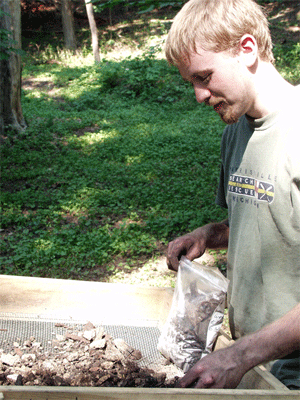
Select on photograph to enlarge
Craig, the author, got quite dirty excavating and sifting the soil from the burnt house foundation.
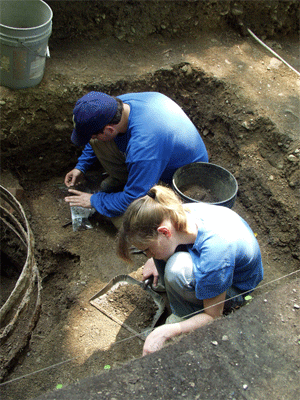
Select on photograph to enlarge
Dr. Sam shows one of our volunteers, Bridget, the nuances of a barrel cistern construction.
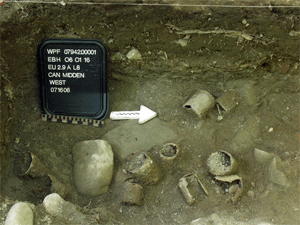
Select on photograph to enlarge
A can midden was uncovered to the north of the main house foundation and totaled 18 cans by its conclusion.
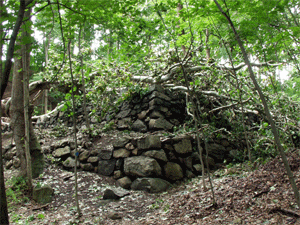
Select on photograph to enlarge
Luckily work at the pond was finished before this large sycamore decided to fall after a storm.

Select on photograph to enlarge
The blast furnace used by the West Point Foundry middle to late nineteenth century has been restored at the Orange County Historical Society. The crew visited here on a rainy day.
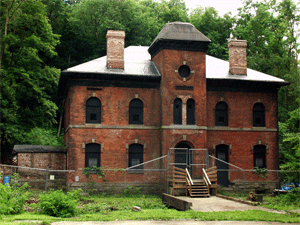
Select on photograph to enlarge
The office building stands tall with modifications to the center of its second story and new protections over its lower windows made since last summer.
|
Greetings from the Hudson! My name is Craig Wilson, and I’m currently an Anthropology/Archaeology major at Michigan Tech. I’ve long been interested in industrial history and technology, and so came out to Cold Spring, NY, to attend Tech’s field school to see (and participate in) industrial archaeology in action.
It’s been a long but productive two weeks since our last Web posting. After an extended weekend for the 4th of July holiday, the entire crew returned to work in several areas around the West Point Foundry site. At the East Bank House, several excavation units were finished up, and more were opened. Inside the house itself, Cal finished work in 3.6A after exposing a brick floor edged by a burned timber. Seeking to better understand what this brick surface was, and how far it extended, Vanessa and I opened a new unit, 3.5A, immediately to the east. After two days of excavation, we discovered that the entire unit was floored with the same brick surface. Several theories about what this brick floor originally was have been postulated, and Vanessa and I have opened another unit, 3.5B, to the south of 3.6A to determine if and where the bricks meet the south wall of the house.
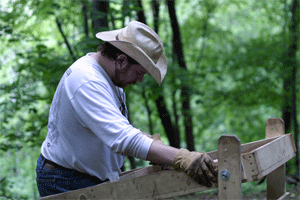
Select on photograph to enlarge
Cal works a screen at the East Bank House.
Outside the house, Sam continues to make progress in 2.7A and 2.7B. After more fully exposing the barrel feature, he also discovered a clay-walled feature lined with cobbles and sterile sand. He is confident that these structures represent a water cistern, one that probably dates to the original construction of the house.
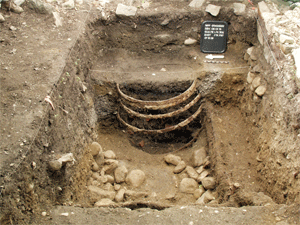
Select on photograph to enlarge
Cobble stones line across the bottom and in front of the barrel cistern. Check back to earlier week's for additional photos of how this feature has been excavated.
Meanwhile, work continues on the northern house extension. After discovering the northeast corner of the addition, Cal, Nikki, Dan, and Paul opened two new units, 2.9A and 2.10A, in an attempt to find the west wall of the addition. These two units have not yielded evidence of the western wall yet, which may mean that the northern house addition was constructed differently than originally thought. However, Cal and Nikki made an interesting discovery in 2.9A in the form of several nearly intact food and tobacco cans.
Excavations have already wrapped up in the industrial core of the site, and the process of writing up and reporting findings has begun. Cameron has already completed his report on the Battery Pond, while I continue to assist Bode with the Boring Mill report. In his research, Bode has discovered interesting new map data which has changed our ideas about the building dates of the various Boring Mill additions and expansions. Somewhat fortuitously, work at the Battery Pond wrapped up just before several large trees fell on the dam wall during a windstorm. Although only minimal damage occurred, it will take several weeks for the trees to be removed.
More recently, we prepared for our second, and final, open house of the summer. Although bad weather kept us out of the field for a number of days, the crew took the opportunity to visit both the newly-reopened Foundry School Museum in Cold Spring and the Clove Furnace, a restored blast furnace in Arden, NY. Fortunately, the weather cleared up for the weekend open house, and over 150 visitors toured the West Point Foundry site. We were also once again joined by Dr. Patrick Martin, professor of archaeology at MTU, who lent his expertise and assisted us in running the open house.
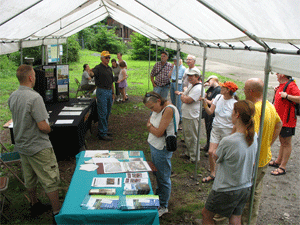
Select on photograph to enlarge
Over 150 people visited the site during our final "Days at the Foundry" open house of the season. We will be returning next year with a similar event.
With the final open house complete, the 2006 field season is beginning to draw to a close. While this coming week is devoted to finishing up excavations and taking final photos, we have already begun to plan the backfilling process. Over the next two weeks, the crew will finish all excavations, complete all reports, and refill excavation units to protect the features we have uncovered. As such, this will be the final Web posting for the 2006 season. I hope you have enjoyed following our archaeological activities and discoveries over the past 11 weeks. On behalf of the entire crew, I would like to thank all of our volunteers, including Bridget and Eileen who joined us this past week, for all of their hard work and assistance. Furthermore, I would like to thank all of you for taking this archaeological journey with us, and invite you to check back during the summer of 2007 for more updates from the West Point Foundry.
Craig Wilson
|



